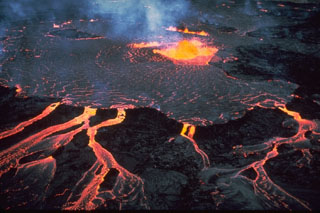Report on Kilauea (United States) — 4 June-10 June 2025
Smithsonian Institution / US Geological Survey
Weekly Volcanic Activity Report, 4 June-10 June 2025
Managing Editor: Sally Sennert.
Please cite this report as:
Global Volcanism Program, 2025. Report on Kilauea (United States) (Sennert, S, ed.). Weekly Volcanic Activity Report, 4 June-10 June 2025. Smithsonian Institution and US Geological Survey.
Kilauea
United States
19.421°N, 155.287°W; summit elev. 1222 m
All times are local (unless otherwise noted)
The Hawaiian Volcano Observatory (HVO) reported that the eruption within Kilauea’s Kaluapele summit caldera, characterized by episodic fountaining and intermittent spatter at two vents along the SW margin of Halema’uma’u Crater, continued at variable levels during 4-10 June. Night incandescence, intermittent lava spattering, gas pistoning, and hydrogen flames at the N vent were visible during 3-4 June. Minimal incandescence at the S vent was observed. Low dome fountaining began at the N vent at around 2055 on 4 June and was accompanied by lava overflows onto the crater floor. Small sustained lava fountains, less than about 30 m high, began erupting at the N vent around 2115. The activity intensified with fountains rising to 100 m by 2210 and over 300 m by 2240. An eruption plume rose 5 km above the ground level by 2250 and was continuing to rise. Sulfur dioxide emissions were estimated at 50,000-75,000 tonnes per day. Large lava flows erupted from both vents and covered about half of Halema’uma’u Crater floor. The N vent stopped erupting at about 0408 on 5 June and the S vent stopped shortly after at 0428. HVO warned that strands of Pele’s hair, present throughout the summit area of Hawai’i Volcanoes National Park and surrounding communities, could be remobilized by wind. Data analysis confirmed that lava fountains rose as high as 365 m, a new record high for the current eruption that began in December 2024. Tephra deposits from the period of high fountaining were several meters thick on the SW rim of Kaluapele, in a closed area of the park, and as much as 60 cm of tephra was deposited at a location 2.4 km SW of the eruptive vents.
Incandescence at the S vent was visible overnight during 7-8 June. Vigorous sulfur dioxide gas emissions, nighttime incandescence, and occasional spatter at the N vent indicated that magma was close to the surface during 8-9 June. Spattering at the N vent became continuous during the early hours on 10 June, followed around 0554 by lava overflows onto the crater floor. The vent continued to generate lava flows during gas pistoning events at least through 1000. The Volcano Alert Level remained at Watch (the third level on a four-level scale) and the Aviation Color Code remained at Orange (the third color on a four-color scale).
Geological Summary. Kilauea overlaps the E flank of the massive Mauna Loa shield volcano in the island of Hawaii. Eruptions are prominent in Polynesian legends; written documentation since 1820 records frequent summit and flank lava flow eruptions interspersed with periods of long-term lava lake activity at Halemaumau crater in the summit caldera until 1924. The 3 x 5 km caldera was formed in several stages about 1,500 years ago and during the 18th century; eruptions have also originated from the lengthy East and Southwest rift zones, which extend to the ocean in both directions. About 90% of the surface of the basaltic shield volcano is formed of lava flows less than about 1,100 years old; 70% of the surface is younger than 600 years. The long-term eruption from the East rift zone between 1983 and 2018 produced lava flows covering more than 100 km2, destroyed hundreds of houses, and added new coastline.
Source: US Geological Survey Hawaiian Volcano Observatory (HVO)

